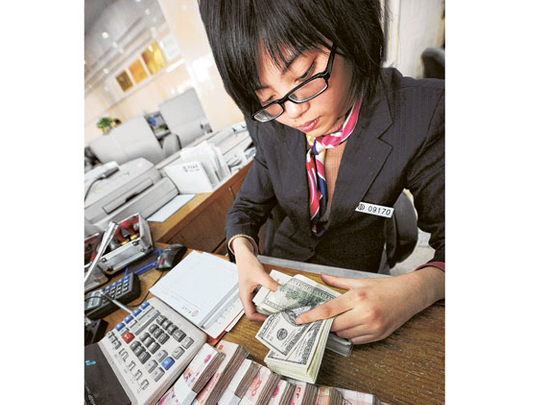
Hong Kong: The nascent offshore yuan market's growth in Hong Kong has been rapid, but its shortcomings are giving rise to a synthetic sister that may grow even more quickly.
Companies and institutions have been steadily queuing to issue yuan-denominated debt in Hong Kong, nicknamed "dim sum bonds", at very low cost, thanks to investors of all stripes willing to accept low yields in return for direct exposure to a currency expected to strengthen this year.
For the borrowers, though, getting the yuan back into China can be a lengthy, complicated process, especially with Beijing getting more hawkish against hot money. Plus, the limited pool of yuan in Hong Kong, while growing, has prevented borrowers from pushing big deals through the market.
Synthetic yuan bonds may be the answer to non-investment grade companies looking to raise funds to bring into China, such as Chinese property developers.
At the same time, the bonds meet the heavy demand for yuan assets among international investors. The hybrid structure of these securities means investors are paid renminbi for lending borrowers US dollars. So the potential pool of investors expands to include anyone with dollars to invest.
"Synthetic bonds are riding on the wave of investors migrating their assets from US dollars to renminbi," said a banker who worked on Evergrande Real Estate Group's jumbo 9.25 billion yuan ($1.41 billion) synthetic deal that priced last week.
Evergrande's two-tranche issuance was the biggest high-yield bond deal ever in Asia.
"The beauty of the deal is that the investors do not need to have any renminbi funding."
Last year only saw one synthetic deal come to market worth 3 billion yuan, while the burgeoning dim sum bond market produced 33 deals worth about 42.6 billion yuan.
Twenty days into 2011 and there were already 15.8 billion yuan of synthetic bonds issued and 4.5 billion yuan of dim sum debt.
Most of the yuan outside of China is collecting in Hong Kong, which has become the laboratory for Beijing's attempts to spread the use of its currency abroad. At its current rate of growth the yuan deposit base in Hong Kong could hit 2 trillion yuan this year from 280 billion yuan as of November 2010.
Symbolic amounts
Last year high-profile multinational companies like McDonald's Corp and Caterpillar Inc tapped Hong Kong's yuan market, also called the CNH market, for symbolic amounts of funding, but the bureaucratic process of moving the money into China is daunting for many borrowers.
Ironically, yuan raised in Hong Kong is treated like a foreign currency by China's foreign exchange regulator. The speed that it takes to get the "foreign yuan" into China depends on the location of the borrowing company's mainland operations, because provincial governments ultimately handle the process.
By contrast, the average time that it will probably take to get dollars raised via a synthetic bond into the mainland is around four weeks, including the time taken for preparing documentation, debt bankers said.
For a repeat issuer, like Shui On Land , which has issued two synthetic yuan bonds in a month, it could take around two to three weeks, they said.
"CNH remittance is approved on a case-by-case basis. There are no clear existing guidelines on this. But the procedures are well in place for dollar inflows into China. There is a clear channel where you go through the necessary steps," Vivian Wai-man Lam, partner with law firm Paul, Hastings, Janofsky & Walker in Hong Kong, said.
Lam advised China SCE Property Holdings on its 5-year, 2 billion yuan synthetic deal that priced on January 7. Unless Beijing makes its capital account more porous in the near term, she expects high-yield borrowers in the offshore yuan market to choose synthetic rather than dim sum bonds, especially since the funds are cheaper than the dollar bond market.
Nomura said in a research note Evergrande's synthetic 5-year paper that priced at 9.25 pe rcent would have had an equivalent yield of about 11.8 per cent if the company did a straight US dollar bond without the renminbi exposure.
For investors, the synthetic bonds are not without their risks.
Evergrande's 3-year and 5-year bonds dropped to 99.25 almost immediately in the secondary market after pricing at par, despite meeting overwhelming demand in the primary market. Some bankers said that this was because investors ended up with more bonds than they wanted because the competitive order book made them over bid.
Risk factors
Another risk is sector concentration. All four issuers of synthetic yuan bonds in the past month have been Chinese property developers. Investors may at some point think twice about the risks surrounding an industry so vulnerable to further policy tightening in China and demand higher yields.
For now expectations of yuan appreciation is clearly outweighing any of the risks associated with yuan assets.
The yuan has risen more than 3 per cent against the dollar since June when China announced it was loosening its grip on the currency. Though it is still tightly controlled, a Reuters poll earlier this month showed economists see the currency rising a further 5.4 per cent over the next 12 months as Beijing tries to quell inflation.
"If investors maintain the view of an appreciating Chinese currency, they will continue to accept a lower yield in return for exposure to an expected rise in RMB value, thus making synthetic RMB bonds attractive vis-a-vis dollar ones for Chinese issuers," analysts from Moody's Investors Service said in a report.












